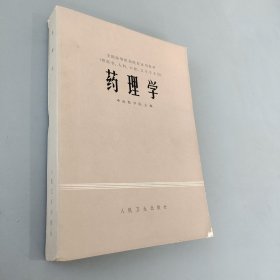
药理学
全新正版 极速发货
¥ 83.06 7.0折 ¥ 118 全新
库存23件
广东广州
认证卖家担保交易快速发货售后保障
作者殷明,朱依谆 主编 著
出版社人民卫生出版社
ISBN9787117241205
出版时间2017-08
装帧平装
开本16开
定价118元
货号1201577358
上书时间2024-11-26
- 最新上架
商品详情
- 品相描述:全新
- 商品描述
-
目录
Section 1 Principles of Drug Therapy
Chapter 1 Introduction to Pharmacology
The Aim of Pharmacology
The History of Pharmacology
Change of Drug Discovery Strategy
Processes of Drug Discovery
Preclinical Pharmacology Research
(Non—clinical Research)
Clinical Trial
Chapter 2 Pharmacokinetics
Process of Drug in Body
Process for Drug Transport across
Membranes and Drug Transporters
Drug Absorption and Routes of
Administration
Drug Distribution and Binding to Plasma Protein
Drug Metabolism
Drug Elimination
Kinetic Process of Drug in Body
Principles of Pharmacokinetics
Pharmacokinetic Parameters and Basic Calculation Equations
Chapter 3 Pharmacodynamics
Specific Mechanisms of Drug Action
Drug—receptor Interactions
Effects on,Enzymes
Effects on Transporters
Effects on Structural and Functional Proteins
Effects on Genes
Common Note Concerning the Drug
Mechanism
Non—specific Mechanisms of Drug Action
Dose—response Relationships
Dose—response Relationship Curves
Relation between Dose—response
Variation in Drug Responsiveness
Sources of Inter—individual Variation of Drug Response
Section 2 Drugs Affecting the Autonomic Nervous System
Chapter 4 Introduction
Anatomy arid General Functions of
Efferent Nervous System
Autonomic Nervous System
Somatic Motor Nerves
Neurotransmitters in the Efferent Nervous System
Acetylcholine
Norepinephrine
Receptors in the Efferent Nervous System
Cholincceptors
Adrenoceptors
Dopamine Receptors
Drugs Affecting the Autonomic Nervous System
Agonist and Antagonist Actions at Receptors
Interference with Synthesis of the Transmitter
Interference with Degradation of the Transmitter
Interference with Storage and Release of the Transmitter
Classification of Drugs Acting on the Efferent Nervous System
Chapter 5 Cholinergic Agonists and Antagonists
Muscarinic Agonists
Choline Esters
Natural Alkaloid Muscarinic Agonists
Nicotinic Receptor Agonists
Anticholinesterase Agents
Hydrolyzation of Aeetyleholine by
Cholinesterase
Reversible and Irreversible Cholinesterase lnhibitors
Cholinesterase Regenerators
Pralidoxime Chloride
Pralidoxime Iodide
Muscarinic Acetylcholine Receptor Antagonists
Atropine and Related Alkaloids
Synthetic and Semisynthetic Substitutes for Belladonna Alkaloids
Nicotinic Acetylcholine Receptor Blocking Aqents
Ganglionic Blocking Agents
Skeletal Muscular Relaxants
Chapter 6 Adrenergic Agonists and Antagonists
Adrenergic Agonists
Characteristics of Adrenergie Agonists
Agonists for α and β Adrenoceptors
Nonselective α Receptor Agonists
Selective α Receptor Agonists
Selective α Receptor Agonists
Nonselective β Receptor Agonists
Selective β1Receptor Agonists
Selective β2 Receptor Agonists
Adrenergic Antagonists
α Receptor Antagonists
Receptor Antagonists
Chapter 7 Local Anesthetics
Classifications of Local Anesthetics
Individual Local Anesthetics
Methods of Administration of Local Anesthesia
Adverse Effects of Local Anesthetics
Section 3 Drugs Affecting Central Nerv0us System
Chapter 8 Introduction to Central Nervous System
Cellular Basis of the CNS Neurons
Support Celts
Neuronal Circuits
Synapse and Synaptie Transmission
Blood—brain Barrier
Ion Channels & Neurotransmitter in the CNS
Ion Channels
Central Neurotransmitters and Receptors
Actions of Drugs in the CNS
Specificity and Nonspocificity of CNS Drug Actions
General Characteristics of CNS Drug Actions
Chapter 9 General Anesthetics
Actions and Mechanism of General Anesthetics
Anatomic Sites of Action of General Anesthetics
Cellular and Molecular Mechanisms of General Anesthetics
Depth of Anesthesia
Measurement of Anesthetic Potency
Intravenous Anesthetics
Common Intravenous Anesthetics
Inhalational Anesthetics
Contmon lnhalational Anesthetics
Current Clinical Practice
Chapter 10 Sedative—hypnotic Drugs
Benzodiazepines
Chemistry
Pharmacokinetics
Mechanism of Action
Pharmacological Effects and Therapeutic Uses
Adverse Effects
New Generation Sedative—hypnotic Drugs
Novel Benzodiazepine Receptor Agonists
Barbiturates and Other Hypnotics
Chapter 11 Antiepileptics
Classification of Epilepsy
Pathogenesis of Epilepsy
Antiepileptic Drugs
Chapter 12 Antipsychotics and Antidepressants
Antipsychotic Drugs
Classification of Antipsychotic Drugs
First—generation Antipsychotics
Second—generation Antipsychotics
Antidepressants
Classification of Antidepressants
Selective Serotonin Reuptske(nhibitors(SSRIs)
Serotonin/Norepinephrine Reuptake
Inhibitors(SNRIs)
Norepinephrine Reuptake Inhibitors(NRIs)
5—HT2 Receptor Antagonist
Monoamine Oxidase Inhibitors(MAOIs)
Other Antidepressants
Drugs for Bipolar Disorder
Antianxiety Drugs
Chapter 13 Analgesics
Opioid Receptor and Mechanism of Action
Opioid Receptors
Endogenous Opioid Peptides
Mechanism of Action
Morphine and Opioid Agonists
Structure—activity Relationship
Pharmacokinetics
Pharmacodynamies
Therapeutic Uses
Adverse Effects
Contraindications
Other Opioid Receptor Agonists
Strong Agonists
Moderate Agonists
Mixed Agonist—antagonist
Opioid Receptor Antagonists
Chapter 14 Drugs for Neurodegenerative Diseases
Anti—Parkinson Drugs
Classification of Anti—Parkinson Drugs
DA Precursor
Levodopa Degradation Inhibitors
DA Receptor Agonists
Selective MAO—B Inhibitors
COMT Inhibitors
N—methyl—D—aspartate(NMDA)Receptor Antagonist
Antimuscarinic Agents
Drugs for Alzheimer s Disease
Acetylcholinesterase(ACHE)Inhibitors
NMDA Receptor Antagonist
Chapter 15 Central Nervous System Stimulants
Drugs Mainly Acting on the Cortex
Drugs Stimulating Respiratory Center
Section 4 Cardiovascular Pharmacology
Chapter 16 Diuretics
Definition and Classification of Diuretics
Physiological Basis of Diuretics
G)omerular Filtration
Reabsorption and Secretion of Substances in Renal Tubules
Common Diuretics
High Efficacy Diuretics(Loop Diuretics)
Moderate Efficacy Diuretics(Thiazides or Thiazide—like Diuretics)
Low Efficacy Diuretics
Dehydrants
Chapter 17 Antihypertensive Drugs
Classification of Antihypertensive Agents
Drugs that Interfere with Renin—angiotensi System
ACE Inhibitors
Angiotensin Ⅱ Receptor Blockers
Renin Inhibitor
Calcium Channel Blockers
Diuretics
Sympathetic Nervous System Inhibitors
Adrenoceptor Blockers
α Adrenoceptor Blockers
α/β Adrenoceptor Blocking Agents
Centrally Acting Adrenergic Drugs
Vasodilators
Combination Therapy of Hypertension
Chapter 18 Antianginal Drugs
Organic Nitrates
Chemistry
Pharmacokinetics
Pharmacodynamics
Mechanism of Action
Therapeutic Uses
Adverse Effects and Drug Interactions
Blockers
Phannacodypamics
Therapeutic Uses
Adverse Effects and Drug Interactions
Calcium Channel Blockers
Pharmaeodynamics
Therapeutic Uses and Adverse Effects
Other Antianginal Drugs
Chapter 19 Drugs Used in Congestive Heart Failure
Drug Classification
Representative Drugs Used in Congestive
Heart Failure
Diuretics
Vasodilators
Renin—angiotensin—aldosterone Axis
Antagonists
Adrenergic Receptor Antagonists
Cardiac Glycosides
Adrenergic and Dopaminergic Agonists
Phosphodiesterase(PDE)Inhibitors
Chapter 20 Anti—arrhythmic Drugs
Electrophysiology of Normal Cardiac Rhythm
Ionic Basis of Membrane Electrical Activity
Automaticity,Conduction,and Refractoriness
Mechanisms of Cardiac Arrhythmias Re—entry
Enhanced Autornaticity
Afterdepelarization
Mechanisms of Anti—arrhythmic Drugs
Slowing Automatic Rhythms
Inhibiting Afterdepolarizations and Triggered Activity
Inhibiting Re—entry
Classification of Anti—arrhythmic Drugs
Ⅰ Na+Channel Blockers
ⅡβAdrenoceptor Antagonists
Drugs Prolonging Action Potential
Duration
Ⅳ Ca2+Channel Blockers
Representative Anti—arrhythmic Drugs
Chapter 21 Drugs for Hyperlipidemia and Atherosclerosis
Pathophysiology of Hyperlipidemia
Normal Lipoprotein Metabolism
Lipoprotein Disorders
Dietary Management of Hyperfipidemia
Drugs Used in Hyperlipidemia
HMG—CoA Reductase Inhibitors
Bile Acid—binding Resins
Cholesterol Absorption Inhibitor
Fibrates
Nicotinic Acid
Antioxidants
Polyunsaturated Fatty Acids
n—3(or ω—3)—type of PUFAs
n—6(or ω—6)—type of Fatty Acids
Combined Use of Antihyperlipidemic Drugs
Section 5 Inflammation,Immunomoudlation and Autacoid Pharmacology
Section 6 Endocrine Drugs
Section 7 Drugs Affecting Other Systems
Section 8 Chemotherapeutic Drugs
Index
内容摘要
《全国高等学校药学类专业规划教材:药理学(英文版)》主要供普通高等院校药学各专业本科生使用,也可供医学及相关学科的本科生参考,还可供生命、化学、农学、食品等专业学生拟进入药学院校或药学相关研究机构攻读研究生学位时复习考试、选修学分和参考使用。
相关推荐
— 没有更多了 —






















以下为对购买帮助不大的评价